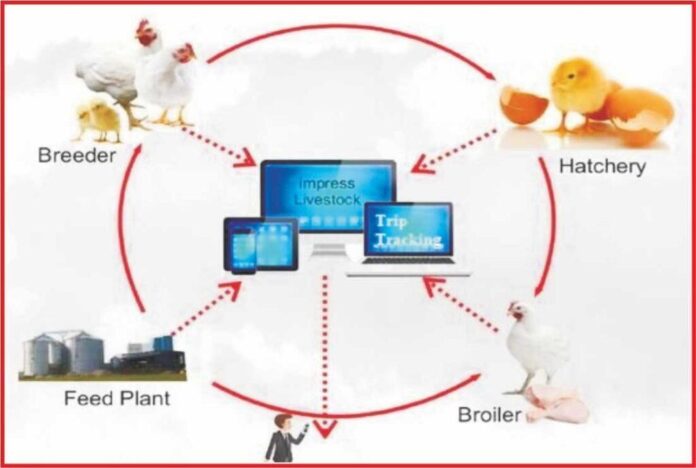Artificial Intelligence in Poultry Industry : Prospects of Automation in Commercial Broiler & Layer Poultry Farming in India
India ranks third in egg production and fifth in broiler production having 851.81 million poultry population with a growth rate of 8.5 per cent. The annual production of eggs has reached to 103.32 billion (Husbandry, B.A. and Statistics, F., 2019; 20th Livestock census, 2019).
In global egg production, India holds the third position, producing a staggering 82.93 billion eggs, and ranks fifth in broiler meat production, yielding approximately 4.4 metric tons as per the 20th livestock census. Poultry production practices have evolved with modernization, leading to a remarkable improvement in broilers’ Feed Conversion Ratio (FCR), which has gone from 2.5 to an impressive 1.6. Moreover, the time taken to achieve the desired body weight in broilers has significantly decreased from 8 weeks to just 35 days (20th livestock census, 2019) . The poultry industry’s contribution to the Indian economy is noteworthy, amounting to about 150,000 crores in Indian rupees, and it continues to play a vital role as the nation’s economy grows (20th livestock census, 2019) . With the rise in per capita income, there is a definite anticipation of increased demand for poultry products in the future. In the realm of computer science, Artificial Intelligence (AI) stands as an essential component, empowering the creation of intelligent machinery that are capable of performing tasks which usually required human intelligence. AI’s broad scope facilitates the integration and analysis of information, enabling data-driven decision-making and enhancing overall business efficiency (Dwivedi et al., 2021) . A prime example of an AI application is evident in Google’s Search Engine, which harnesses human intelligence to develop a platform where users can access information related to any topic by simply entering relevant keywords in the search box. Google’s implementation of Artificial Intelligence significantly reduces the effort needed to obtain information from the vast expanse of the internet (Ilager et al., 2020) .
Majority of the poultry owners follow the open house conventional rearing system. The higher short term costs and easy availability of man power shows reluctance among farmers to opt modern technologies. The trend in poultry production has been towards large commercial farming. This compels the farmers to switch over from traditional practices to mechanized farming which saves time and labour. This includes mechanical cleaning equipment; automatic feeding and watering equipment, medication, egg collection, litter removal etc. The use of these types of equipments makes it possible for large number of bird to be handled in the operation. Controlled feeding and automating the controlled feeding system of broiler for optimum nutrition is a beneficial step and must be applied in poultry enterprises. Poultry production in India has continuously faced challenges of providing optimum environment for maximum growth, production, disease control and finally the cost benefit ratio involved for a successful poultry husbandry practices. In order to sustain growth and profitability, it is becoming essential to create innovative ways to decrease the cost of production as much as possible and at the same time to produce high quality products. Factors like feeding, watering, handling, vaccination and medications must be optimized to improve returns and economic feasibility. Maintaining or/and improving performance of birds, may be achieved by improving farm management practices.
The following automation and robotics done in the different segments of commercial Broiler farming:
Automatic Pan Feeding:
These are auger driven feeding system of poultry feed. The auger is generally composed of special alloy known as Mangalloy. Mangalloy, also called manganese steel or Hadfield steel, is an alloy steel containing an average of around 13% manganese. Mangalloy is known for its high impact strength and resistance to abrasion once in its work-hardened state. The usage of this alloy will increase the surface toughness by three times which makes the feeding system more durable An automatic pan feeder system (Fig 1), particularly for raising chickens, and controlling the level of the feed in the pan, includes a pan assembly which has an adjustable skirt that determines the level of the feed, such skirt being adjustable by two structures. The first structure is an intermediate member between the drop tube and the skirt which is adjustable on the drop tube for adjusting the vertical position of the skirt. The second structure is the adjustment of a skirt by an anti-roost wire tied to the skirt by ties. The anti-roost wire is movable along the elongated; such movement asserts a pull on the ties which raises the skirt to adjust the level of the feed in the pan. Another feature of the invention is a cone shaped deflector member mounted on the central axis of the drop tube for deflecting both the fines and coarse particles of the feed outwardly towards the outer periphery of the pan to eliminate the fines from accumulation in the central area of the pan (Hart,1995). This deflector member is adjustable for shutting off the flow of feed through the drop tube.
Climate Control Poultry Shed:
In climate controlled poultry house (Fig 2), external air is drawn or pumped through very dynamic large fans of high efficiency HEPA filters(Fig 3), efficient to remove almost 99.97 % of the airborne particles with size 0.3 micrometers or larger. This system will rely on the principle, cooling outdoor air by passing it over water-saturated pads, causing the water to evaporate into it. The 15°- to 28°F-cooler air is pushed into the poultry house then and distributed by using a duct system. According to a private entity involved, number of birds housed in Climate controlled shed and income is double than conventional system of rearing of commercial broilers.
Nipple drinking system:
These drinking nipples are made of high-alloy stainless steel. The plastic components of the system are made up of high density polyethylene. Drinking nipples and automatic drinkers for rearing chicks are sturdy and precise. They contain no delicate operations. These designs guarantee long life and minimal maintenance. The valve components and large cross-section arrangement provide optimal protection against contamination (Hawk, 2008).These drinking system is connected with filtration unit which reduces the pathogens and hardness of water for the poultry. Thus nipple drinking system ensures continuous water supply throughout day and night, less spillage of water thanks to cup attached to the system results reduction in litter moisture, improved rearing result and minimum maintenance, care, and cleaning .One of the study reported that nipple drinking system doesn’t allow to microbes like E. coli to produce biofilm compare to bell drinker system.
Automatic medicine dispenser:
Automatic medicine dispenser or automatic medicator is the another assembly in this type of drinking system which utilized for water medication, water vaccination, water acidification, water supplementation, water sanitation, water disinfection, hygiene & biosecurity .The Automatic medicator operates by using the gravitational water flow as a source of energy. The pressure and flow of the water trigger the motor piston which drives a dosing piston. The additive is injected and mixed continuously with the water from the mains supply at the selected dosing rate % (rate of product/water incorporation). The dose of concentrated additive is directly proportional to the volume of water which passes through the automatic medicator, independently of variations in the flow rate and pressure of the mains water supply (Chehri X Dosatron®, 2010).
Broiler Chicken Harvester
Broiler chicken harvester moves around the shed and picks up 200 birds at a time in about 30 seconds. Once the harvester is fully packed then it places the birds onto a hopper and returns to the shed to pick up another batch of birds. The Chicken harvester is capable of catching and handling up to 8000 birds an hour and can operate in either a clear span or posted shed The Chicken harvester is driven by one operator and it rules out the need for repetitive manual catching and there is no longer any human contact with the birds during the catch. The results will be consistent since there is no manhandling of birds. Lifting of broilers birds is more laborious and exhaustive job and person employed for the manhandling will get tired and not able to perform the task for rest of the day. This Chicken harvester machine will aid to maintain the welfare of chicken since the birds are never picked up by the legs and carried upside down, as a result they tend to flap which can cause injuries. A trail was conducted to compare the manual handling and chicken harvester for lifting the broiler birds and results shows that there is significant reduction in leg and wing damage when broilers are lifted by chicken harvester. This system also ensures the human welfare as the catcher driver can wear an air filtration mask to isolate them from the dust, compared with a manual catcher who finds difficulty in working with mask due to more cardio nature of the job.
The Poultry sector is a most important segment of the livestock industry. This sector consists of many different levels of production, including breeding farms, hatcheries, feed factories, , broiler and layer farms and proczessing plants. Likewise, there are sub-units such as chicken, quail, duck, turkey, guinea fowl and goose in terms of species in the sector. In terms of infrastructure, different types of housing from thatched shed to automated, environmentally controlled sheds, normal feeders to automatic feeders and regular channel watering systems to automatic cups and nipples, automatic egg collection, refrigeration systems, nutraceutical and medicine manufacturing units, vaccine manufacturing units, manufacturing mechanical components to electronic gadgets required for various functions. Rendering plants and production for feathers. Therefore, it involves all the derived sciences such as physics, chemistry, biology, biotechnology, and other engineering skills. There is enormous growth and progress in this sector and the sub-classes for production are divided into meat and egg production. All these have gradually grown from back yard to industrial proportion over six decades (1960 to 2020) owes to veterinarians, poultry scientists, technical and non- technical persons and dedicated farmers.
With all the developments yet there is organized and unorganized sectors in poultry in our country. Organised sub-sector needs conducive environment to grow for which policy support & intervention is required mainly for disease surveillance, drug residue and drug/ vaccine quality control, standardization & quality control of poultry feed, eggs & meat, application of HACCP (Hazard Analysis and Critical Control Point) and Good Manufacturing Practices (GMP) for compliance to WTO & CODEX norms and gradation, value addition, brand promotion & export boosting etc.
By the end of this decade, globally, poultry meat is expected to represent 41 per cent of all the protein from meat sources, according to the OECD-FAO Agricultural Outlook 2030.
The Indian poultry industry is poised to benefit from the ongoing changes in lifestyles in general and eating habits in particular. No wonder, the share of organised commercial farms is rising as it is largely modernized and technically improvised.
According to government data, egg production has been rising steadily, having risen from 95 billion in 2017-18 to 105 billion the following year and to 114 billion in 2019-20. Similarly, poultry meat production, too, has been expanding. from 3.7 mmt in 2017-18 it grew to 4.1 mmt the following year, and then on to 4.3 mmt in 2019-20.
Although ambitious, some projections suggest, by 2023, the country may produce 136 billion eggs and 6.2 ml t poultry meat.
The global poultry market reached a value of nearly $319.2 billion in 2019, having grown at a compound annual growth rate (CAGR) of 5.5% since 2015, and is expected to grow at a CAGR of 6.1% to nearly $405 billion by 2023. The market is expected to grow at a CAGR of 7.2% to nearly $465.7 billion by 2025, and at a CAGR of 6.8% to $645.7 billion by 2030.
Change in the farming systems
The progress in is all sectors of poultry is due to the advancement of technologies in the management, nutrition and health care systems. Over the years, the successors of farmers now are with highly qualified and having double degrees, Technical / engineering and even medical and veterinary professionals. Therefore, the poultry industry is now in the hands of well leaned and educated groups. They always think differently and adopt any technology available globally for the benefit of profitability. These are not only innovators but also have open mind to accept and adopt any innovation that are useful in modern poultry farming. The new farming systems are called “Smart farms, Automated farms, Mechanized farms and Digital farms.
New Trends in Poultry Farming
Two years ago ( March 11, 2020) the World Health Organization formally declared a pandemic caused by a novel coronavirus. And as COVID-19 spread across the globe, humanity had little time to adapt to lockdowns and staggering losses.
The COVID-19 pandemic has severely affected many economic sectors across the world, including livestock production. It has also sparked fears of an impending economic crisis and recession. Disrupted production and transportation, declining consumer demand and volatile markets brought huge financial difficulties, even leading to the permanent closure of many farms. Social distancing, self-isolation and travel restrictions have led to a reduced workforce across all economic sectors and caused many jobs to be lost. Schools have closed down, and the need for commodities and manufactured products has decreased. In contrast, the need for medical supplies has significantly increased. The food sector is also faced the increased demand due to panic-buying and stockpiling of food products. More than the above, the problems started in labour management and this lead to adopt new innovative ideas in poultry farming. In short 2020 was a critical year- COVID-19 posed numerous challenges for the poultry industry, from worker shortages to interruptions throughout the supply chain. The New technologies can help the industry solve these issues and look forward to future opportunities to thrive and succeed. This paper deals with the adoption of several such advances and innovative products for a successful poultry farming.
The following are emerged as some of the new trends in poultry Farming:
- Is there a genetic solution for preventing male chicks?
- 3D cameras could capture precision broiler weights
- MRI technology can help identify which eggs are fertile
- Could smartwatches solve poultry processing’s labor problem?
- 24/7 feedback loops could improve poultry flock outcomes.
- Collaborative robots could further poultry automation
- In-line poultry chilling could be improved using kinematics
- Preventing antibiotic resistance in poultry using peptides
- Digital technologies set to simplify poultry data analysis.
- Hyperspectral imaging could help find poultry meat defects.
- Machine vision can detect broiler floor distribution.
- Will CRISPR transform the poultry industry?.
- Robots are ready to meet poultry processing challenges.
- Automation helps prepare case-ready poultry for the future.
- Digitalization can optimize poultry productivity planning
- Healthy chicks establish adult poultry microbiome quickly.
The Technologies that could disrupt future production and processing operations are:
Remote sensing
Remote sensing allows visibility in real-time on a number of factors, conditions within the poultry house, bird performance, bird health and welfare. Not only is it the case that the farmer can keep watch over the status of sheds and birds when they decide to take a look at the computer but importantly the readings from these sensors can be set to provide “alerts” to management if any parameter falls out with the agreed requirements for the specific age of birds 24/7.
- Sensors can help streamline the data collection process for both birds and workers, resulting in precision poultry production.
- Application of the smart phones helping the owner to monitor real time environmental contexts such as temperature, humidity, ammonia gas, water level.
- In this system describes an Integrated Solution for Smart Poultry Monitoring Using WSN (wireless Sensor Network) and GPRS Network.
- For example, in poultry, sensors can be used to help estimate body weights and measure the flock uniformity.
They can also help solve labour issues and improve worker retention and food safety when used as a wearable sensor for employees.
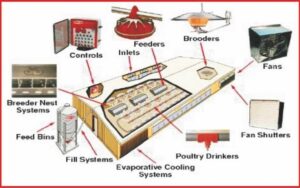
Fig:1.Use of gadgets at different stages of poultry operations
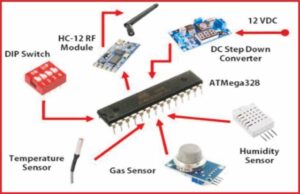
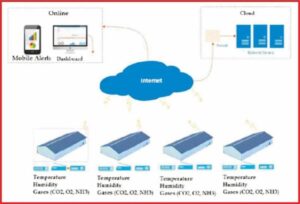
Fig:2. Automation and use of internet to measure the data generated in different houses
Automation and Digitalization, Big data: a major value chain in poultry Industry
- Automation can be used to replace manual labor on poultry farms when it comes to repetitive tasks like checking bird welfare, removing welfare, vaccinations and managing litter.
- In processing plants, there are robots that can cut meat from the bones, which could help space out workers at risk of COVID-19.
- The integration of wireless sensors and GPRS network to control and automatically monitor environmental parameters in a poultry farm.
- The environmental parameters like temperature, humidity, ammonia gas control etc.
- The person in-charge can able to get the internal environmental situation of poultry farm by receiving a message on registered mobile number
- Robotics and automation
Robotics and automation generated intense interest for their potential to reduce labor, be on duty 24/7 and report remotely. Robotic technology can encourage broiler breeders and layer hens to move around the house, reducing the incidence of floor eggs and stimulating fertility, improving bird health and welfare and reducing the amount of labor required. The robot can save up to 50% of a farmer’s time, reduce the number of trips by two-thirds and improve working conditions.
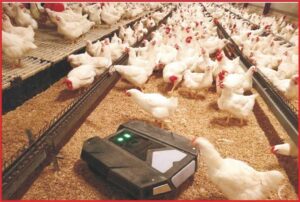
Fig:3. Robots in poultry operation
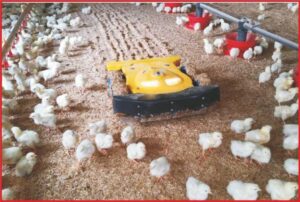
Robotic technology that uses artificial intelligence to help farmers make data-driven decisions about broiler production could result in a healthier, more productive growing environment. Use robotics to encourage the birds to be more active to increase muscle mass, which ultimately drives better improvements when it comes to the feed conversion ratio.
Robots offer not only increase productivity and profits but their presence can also contribute to improved health and welfare. Some robots will continuously scratch the litter to eliminate caking and wet spots, reducing the incidence of pododermatitis, foot burn and breast burn(fig4). Others can monitor and map ammonia, temperature and humidity levels throughout the house. This is valuable information for producers who can adjust ventilation and address any localized issue that may affect bird welfare or productivity. These corrections can prevent a localized issue from affecting the entire flock.
a). Collaborative robotic technology : is one of the most popular new trends in automation.
Collaborative robots, also known as ‘cobots’ are designed to work safely alongside human workers. Typically, the robot is responsible for any repetitive task, freeing up the human worker to perform more complex, thought-intensive tasks. The robot that navigates poultry house floors using imaging sensors and machine learning, has the capability to detect and pick up floor eggs and sense environmental temperatures, gasses and light levels. Robots can free up human workers to perform more complex, thought-intensive tasks, streamlining operations.
Some of the benefits of Cobots include:
- Cost-effective approach to simpler applications
- Improved ROI calculation for low-speed applications
- Ability to implement robots into space constrained applications
- Shorter programming time
- Quicker deployment
b). Chicken Boy, an autonomous ceiling-suspended robot incorporating artificial intelligence and sensors, assesses ambient conditions, health and welfare and equipment failures. Already on the market in Europe, developers at Farm Robotics and Automation planning to continue adding capabilities including removal of dead birds and analysis of litter moisture.
- Monitor poultry floor distribution with machine vision
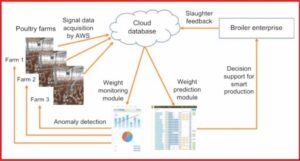
Fig 4: Smart poultry production and data recording for anaysis
In commercial bedding floor poultry houses, bird density and distribution pattern are critical factors for evaluating production management and animal health/welfare. Currently, daily routine inspection of broiler flock distribution in commercial grow-out houses is done manually, which is labor intensive and time consuming. This will also indicate how a machine vision-based method can monitor floor distribution of chickens in drinking, feeding and resting/activity zones. This study provides the basis for developing a real-time evaluation tool to detect broiler chicken floor distribution patterns, behaviors and welfare indicators in commercial production facilities.
The egg sector also has its fair share of applications for AI. The quality of the egg white for instance, the absence of any trace of yolk – is important for many applications requiring optimum egg white foaming. Modern breakers operate at very high speeds, in the order of 200,000 eggs per hour or roughly 60 eggs per second, making it impossible for the human eye to detect an issue.
a). Artificial Vision: In poultry processing the use of artificial vision offers real-time yield monitoring of high-value chicken parts, allowing supervisors to immediately give feedback to employees who can address any potential deficiency. Artificial vision also constitutes a standardized method that can be used to compare results between workers, shifts and processing plants, particularly valuable for large companies operating across multiple sites. Artificial vision can also be combined with smart automation to optimize efficiencies; for example, where broiler parts are automatically sorted after inspection. For processors, AI allows higher processing speeds and accurate packing of premium value products, translating both into more profits and fewer customer complaints. Researchers are now looking at means to totally replace human intervention for some specific tasks considered painful or hard to achieve accurately and consistently.
b). Woody Breast Detection with machine vision and high-speed cameras is capable of detecting and/or sorting breast fillets at normal line speeds without contacting or damaging fillets. Muscle rigidity is measured as the fillets move on and fall off a conveyor.
c). 3D Bird Deboning Cutting Virtual Reality generates cutting trajectories for automated poultry processing systems. It is under development at Georgia Tech Research Institute. Testing started with models but now is on real birds.
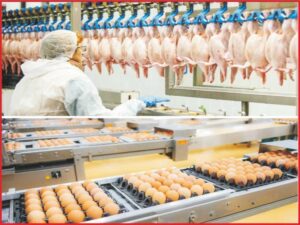
Fig: 5. automation in checking of meat and eggs.
d). Food safety
Food safety is a critical concern in the poultry business, and the innovations. This needs to be addressed both the live production and processing stages. All the above technologies developed ultimately help the production of safe food for human consumption.
- Technicon Composite-housing Gearboxes
with steel endoskeletons eliminate rust, dissipate heat and withstand wash-down processes. Housings are corrosion-resistant and blended with an antimicrobial material that does not exhibit odor or staining in harsh environments. Market launch is perhaps two years away, and prices of the composite gearboxes are expected to be competitive with units with painted cast-iron housings.
- Clear Labs Next Generation Sequencing
Using advanced data analytics and bioinformatics tools for detection and serotype identification of Salmonella spp. in samples taken from carcass rinses, ground poultry, poultry parts, boot swabs and equipment swabs. The system’s accuracy reduces inventory holding time and delayed shipments, confirmation costs and delays, and retail short-supply penalties.
- Big data and artificial intelligence
Harnessing the increasing amounts and complexity of data available to the poultry enterprise is not only a daunting task but a huge opportunity (fig. 6 and 7).
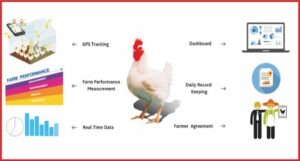
Fig 6. Data generated by breeders, Hatchery, Feed plant and Farms are computerized
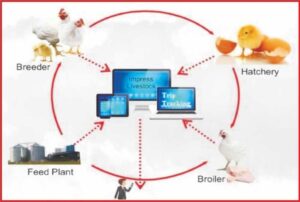
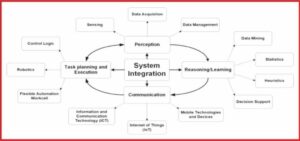
Fig:7. System integration in poultry operations
- Artificial Intelligence(AI)
Artificial intelligence, when applied to broiler and egg production, may not only improve efficiency but help producers address following challenges.
- Scientists are now teaching machines how to recognize any sound of distress or discomfort to aid in monitoring bird wellbeing.
- Another area with great potential for AI is its use in detecting early stage disease.
- AI has the potential to assist in detecting diseases during their incubation period, allowing producers to quickly prevent spread throughout a flock.
- AI can also help with disease diagnosis.
- Using AI to complement or augment the human brain – collaborative intelligence – will give us the potential to be more efficient and accurate in diagnoses.
- Other areas for AI include feed formulation optimization, genetic selection and hatchery management.
- All segments of the poultry sector will be able to benefit from applications using AI.
- Using advanced artificial intelligence software, integrators can find solutions through data that would otherwise difficult to perceive.
- New artificial intelligence technology can help integrators save money and get better flock performance by facilitating investigation and decision making.
- Little Bird Feed Cast System
This estimates the amount of feed in on-farm bins using a small device to apply vibration to the bin surface along with sensors and software. The solar-powered units wirelessly report feed levels via web portals and a mobile app to growers, feed mills and integrators. The web portal presents a history of a house’s feed levels and displays projections. Feed outages are reduced or eliminated and less feed is reclaimed at the end of a flock.
- Poultry System Simulation Model ( PYSSM) :
Simulates the water, energy, wastewater and labor utilization of a poultry processing plant. Based on VENSIM [http://vensim.com/vensim-software/] software, the model simulates all processes that require water use. Designed by developers at Georgia Tech Research Institute as a decision making tool with predictive capabilities, there are modules for labor, water, energy and wastewater processes.
- Machine Learning: Statistical Process Control (SPC)
Uses machine learning and historical location-based data as well as plant-level outcomes to dynamically model the live operations supply chain, predict outcomes and apply outcome scores. It allows quicker and more accurate identification and response to potential changes in variables that impact food safety or production outcomes throughout the poultry supply chain.
- How Audio -Analytic -Software detect respiratory disease
- New analytical software can detect symptoms of laryngotracheitis, infectious bronchitis and potentially other diseases as well as welfare issues.
- Thanks to machine learning techniques, audio software can help farmers detect sick birds before they can.
- The two diseases IB & ILT are primarily detected by a farmer present in the house who hears the coughing of the birds.
- The amount of days that pass after an outbreak are critical in the progression of the disease and its potential damage to a flock.
- If there were a way to automatically detect it instead of waiting for a farmer to randomly encounter it, it could make detection of the disease and treatment quicker. Create a hardware and software system to detect and recognize the specific sounds of an avian cough symptomatic of the conditions among the noise of the poultry house.
- The research was able to identify certain auditory shapes in the sonic spectrum of the house that correlated with the coughs. The next challenge was to teach a machine to recognize those shapes and share the detection with its user.
- Simple Vet Regulatory Compliance Data Management
This applies Blockchain technology to veterinary records to maintain transparency and traceability while also providing analytics to evaluate efficacy of treatments. A suite of integration tools integrate data sources, including public and private block chains, traditional databases and systems and internet-of-things (IoT) enabled devices such as RFID tags and remote sensing technology.
- Block Chain Technology (Value Chain Management)
Uses predictive analytics and deep learning analysis to display and forecast future performance throughout the supply chain. An integrated view of operational data allows finished product to be traced back through the value chain at a minute level of detail. The cloud-based platform uses block chain technology and deep learning neural networks to monitor poultry operations at large scale and across regions.
- Block chain’s opportunity in the poultry industry is its ability to resolve food safety and transparency issues. Walmart, Unilever, Nestlé and other food giants are working with IBM using block chain technology to secure digital records and monitor supply chain management, ensuring traceability of the poultry products sold in stores.
- Block chain can be used to monitor all aspects of the food supply chain, from farmers and producers to processors and distributors. This is Walmart’s third experiment with block chain, and the increasing interest of other large food conglomerates demonstrates the unique capabilities of this technology.
- Transport Genie
Records micro-climate conditions of live poultry during transport, including real-time communications with the driver and key stakeholders. If a threshold is exceeded, an alert is sent automatically. The sensor can be used by processors to improve bird welfare during the loadout, in transport and in plant holding sheds.
- Gene Editing Technology (egg XYT CRISPR )
Inserts a bio-marker in the DNA of male chicks at the parent stock level to create an optical signature in embryos detectable at the breeding/hatching operation. Upon scanning of incoming eggs, those with male embryos are diverted to food production. A pilot study in a poultry layer flock is planned for late 2018. Developers are said to be in negotiations to incorporate the technology in the stock of a major breeding company.
- Microbiome and Life sciences
Advancements in genetics, microbiology, poultry health management, nutrition and more help improve flock management to raise healthier birds. In human medicine, the microbiome has been linked to everything from intestinal health to obesity and mental disorders. Scientists are now applying these findings to poultry, developing probiotics to help control Bacterial and protozoal diseases and to improve the immunity.
a). Edible Vaccines enable chicken producers to dose room-temperature stable vaccine in the feed for both mucosal (in the gut) and systemic (intracellular) protection against coccidiosis. The technology platform inserts genes for specific antigens into corn plants to create the vaccines.
b). Phytogenic Blends for Coccidiosis Control chemically block receptors specific to parasites and physically disrupt the parasite cuticle. The blends are composed of GRAS-listed terpenes that naturally occur in food plants known to be safe as food flavorants. Using a proprietary encapsulation technology, the formulation will be active in the intestine of the chicken.
c). General Probiotics Antimicrobial Probiotics are genetically modified microbes for use in the feed or water of poultry that can detect pathogens and secrete antimicrobials against pathogens, secrete multiple antimicrobials lowering resistance emergence and/or secrete engineered antimicrobial lysins. Prototypes against Salmonella, Campylobacter and Clostridia have been developed. The company expects to complete regulatory requirements and bring the products to market within three years.
d).Nutritional Technology: Digital tools like artificial intelligence (AI) can help poultry producers optimize the decision-making process when it comes to feed management and assessing the health of the gut microbiome. AI-powered tech can provide recommendations how to improve the feed composition to recommendations to improvements in farm management practices with the goal of improved performance and health of the flock.
The nutritional research focus, henceforth, will be influenced mostly by the following innovations:
- Feed formulation software and feeding programmes
- Novel feed ingredients and feed additives
- Gastro-intestinal conditioners for gut health, birds’ welfare and food safety
- Modern technologies for feed processing and feeding packages
- Perinatal nutrition and epigenetic programming
- Advances in AI could lead to a better understanding of the poultry gut microbiome.
- In recent years, the microbiome has captured the attention of researchers, who have linked the microbial makeup of the gut to a variety of poultry diseases and other conditions affecting flock health.
- The health of the gut microbiome, a collection of microorganisms present in the gastrointestinal tract, can be affected by changes in raw materials, diet, additives, vaccine programs and farm management practices.
- Techniques of in-ovo-nutrition
A combination of statistical analysis, machine learning and AI can work together to create insights and recommendations on the status of a flock’s microbiome, based on data from a non-invasive cloacal swab-sampling of live birds. Producers can use this information to determine what actions to take to improve flock performance.
18). Nanotechnology for virus detection
Nanotechnology plays a pivotal role in the mechanism of tracking virus entry. The single virus tracking technology (SVT) makes it possible to track the different stages of a single virus in its life cycle, thus providing dynamic insights into the basic process of virus occurrence in living cells (Liu et al., 2020) It help in trap avian flu viruses for early detection.
Biosensors have come up with a lot of promises in terms of detecting viruses and diseases connected with them. The development of various types of such biosensors such as Affinity-based Nano-biosensors, Nano island affinity-based biosensors, Graphene affinity-based biosensors, Nanowires based biosensors, Optical Nano biosensors, Fiber optic Nano-biosensors, Surface Plasmon Resonance (SPR) based optical Nano-biosensors, Total internal reflection fluorescence, Surface-Enhanced Raman Scattering (SERS), Electrochemical Nano-biosensors had helped us in the rapid and sensitive detection of viruses. Aid to these Nano sensors, viral detection now becomes very sensitive, rapid and cost has come down to a significant low. In this review, an attempt has been made to compile all of the different Nano-biosensors and their applications. Due attention is given to the fact that the reader gets the grasp of the concept with much ease.
Artificial intelligence in poultry industry
Recent advancements in machine technologies have significantly revolutionized daily activities in poultry production, aiming to reduce labor requirements, enable 24/7 monitoring, and facilitate remote reporting. Notable examples include the implementation of specialized robots like GohBot and Chicken Boy. GohBot, equipped with imaging sensors and machine learning capabilities, adeptly navigates poultry house floors, collecting floor eggs, and monitoring environmental factors such as temperatures, gases, and light levels. Chicken Boy, an innovative autonomous robot suspended from the ceiling, utilizes artificial intelligence and sensor technology to evaluate the surrounding environment, identify equipment malfunctions, monitor the health of poultry and perform tasks such as removing deceased birds and analyzing moisture levels in the litter. (Thornton, 2018).
Utilizing Artificial Intelligence (AI) in the poultry industry offers numerous benefits. By reducing human interference on the farm, the risk of infections can be minimized. Moreover, machines and robotics often outperform humans in numerous processes, rendering them more efficient. The benefits of AI in the poultry industry will be explored further, addressing how it can create a positive impact in this domain. To facilitate the seamless navigation of GohBot within the poultry house, it employs cutting-edge technologies such as indoor ultrasonic GPS and Microsoft Kinect depth data to detect obstacles. By employing path planning and obstacle avoidance routines, GohBot can autonomously operate while safely avoiding interactions with chickens. Additionally, clever routines, like the “nudging routine,” gently move birds out of the robot’s path, and a “Drive around” routine helps recompute the robot’s path in case a bird doesn’t move or encounters a static obstacle.
Farm Management
Big data is instrumental in improving farm management practices, particularly in the agriculture industry, where a significant amount of data is still collected manually. Recently, computers have been employed to store farmrelated information, with data stored in spreadsheets or specialized software. However, the potential of big data lies in utilizing cloud storage to store vast amounts of information, which can be leveraged by machines and robotics to control critical parameters such as humidity, temperature and light. Machine learning is becoming a potent tool that will revolutionize the future of farm management practices. With the help of machine learning, robotics can accurately monitor a wide range of important parameters essential for efficient farm management. AI goes beyond merely collecting data; it can process the information using data analytics, drawing from pre-stored data in the cloud. By employing AI to analyze data, instant decision-making becomes possible, significantly improving the farm’s efficiency. To illustrate, robots can be programmed to gather data on managemental and environmental levels inside the farm. This data is then processed, enabling machines to autonomously make decisions related to ventilation, a critical but repetitive task that impacts farm efficiency and profitability. Machine learning and data analytics efficiently manage such tasks, continuously monitoring farm activities, which can become cumbersome for humans. Several universities are currently evaluating poultry farming control systems that use technologies like Zigbee and Raspberry Pi integrated with wireless sensors and GPRS. These technologies are expected to enter the poultry industry on a larger scale shortly. Moreover, Artificial Intelligence can be applied to activities like feeding, watering, and sanitization, streamlining and automating these essential tasks. Data analytics plays a crucial role in predicting future outcomes by gathering and examining current data. For example, through continuous monitoring and analysis of present data, it becomes possible to make accurate projections regarding the weight of birds after a 30-day period. The implementation of AI in farm management will bring efficiency, accuracy, and faster decision-making to the system.
Disease Management
Disease management holds utmost importance in farming practices, as every aspect of farm activities is closely linked to it. Implementing machine-based disease management can be intricate, considering the diverse symptoms and numerous possible diseases. However, Artificial Intelligence (AI) is expected to simplify this process shortly, particularly through its role in assisting with diagnosis. This is where machine learning and big data come into play, proving instrumental in effective disease management. Using cameras installed on farms, AI can swiftly identify issues like huddling and cannibalism among birds, promptly notifying caretakers to make faster decisions and minimize losses. Birds often exhibit unique vocalizations and abnormal behavior during illnesses. By feeding data on such peculiarities into the system, machines can be programmed to alert veterinarians immediately upon detecting any concerning behavior. Moreover, mobile applications can aid pathologists and consultants in confirming diagnoses. These applications can utilize mobile cameras to provide better diagnostic insights. However, creating such applications requires a substantial amount of data. In-farm machine systems can leverage this data to diagnose diseases and promptly notify farm caretakers when intervention is required. In 2012, Oxford University scientists conducted a noteworthy experiment called “Chicken Time Warp,” revealing that the coordinated movement of a flock can help detect diseases up to a week before their actual onset. Such predictive capabilities can assist farmers in countering disease-related losses and have the potential to be applied to various deadly poultry diseases. In summary, AI-driven disease management holds great promise for the poultry industry, with machine learning and big data playing pivotal roles in enabling early detection, accurate diagnosis, and timely interventions, ultimately leading to better disease control and reduced losses for farmers.
Trials and evaluation of nutrition and medicinal products
Artificial Intelligence (AI) offers remarkable efficiency in gathering and processing data, especially during or comparative trials of various products. Machines and sensors can monitor numerous data points simultaneously, a task that would be time-consuming for humans to handle. AI serves not only in gathering data but also streamlines the evaluation of results through analytics, presenting comparative outcomes supported by statistical analysis. Furthermore, AI accelerates the evaluation of the impact of different feed formulations, a task practically unmanageable for humans at such speed. Programming and robotics, enabled by AI, contribute to enhancing breed genetics by identifying breed characteristics and simplifying decision-making in the selection process. These applications significantly reduce trial costs while ensuring precise results. The costly affair of research and development (R&D) in any industry can be efficiently managed with AI’s capabilities. AI empowers companies to conduct multiple studies within a single trial, a feat that would otherwise demand significant human effort. In summary, AI’s prowess in data collection, processing, and analytics greatly enhances the efficiency and costeffectiveness of conducting trials, comparative studies, and research and development in the poultry industry. It streamlines processes, delivers accurate outcomes, and empowers better decision-making, leading to significant advancements and improvements in poultry farming practices.
Post farm activities
AI has already made significant strides in the poultry processing industry in many developed countries, leading to remarkable improvements in efficiency. Meat processing companies are exploring advanced technologies such as Artificial or machine vision to sort broiler parts and detect diseased carcasses. AI-powered machines can precisely distinguish between muscle mass and bone density, making automation of processes like deboning highly efficient through AI. Similarly, in the layer farming sector, AI is employed for tasks such as egg collection, grading, and rapid identification of high-quality eggs. The integration of machine vision and smart automation has significantly improved the carcass quality and packaging in the poultry processing industry. Spectral-line Imaging systems have proven effective in accurately presorting broiler chicken. A leading player in the field, Tyson Foods, has successfully deployed a computer vision system equipped with cameras, machine learning algorithms etc. This system effectively monitors the quantity of chicken moving through the production lines. The company has plans to expand the use of smart automation and AI across all its plants nationwide. With the growing global demand for protein, including in India and other regions, these AI-driven technologies are poised to have a significant impact on providing high-quality chicken and eggs at a lower cost. The poultry industry encounters several obstacles, including elevated raw material costs and the looming risk of diseases like Avian Influenza. However, AI’s beneficial influence on the industry has the potential to enhance process efficiency, thereby increasing affordability of chicken and eggs for a broader segment of the population.
Miscellaneous uses
AI is a versatile technology with several applications that can impact the poultry industry in many ways. In particular, machine vision and smart automation offer significant benefits to feed and nutrition companies, vaccine companies and pharmaceuticals. These technologies improve accuracy, and efficiency, and enhance quality control in their manufacturing facilities. Large integrators in the poultry industry encounter the difficulty of managing farms that are dispersed across various geographical locations. AI can help overcome this obstacle by enabling integrators to collect and analyze data from multiple farms, even if they are situated at various locations. Furthermore, AI enables remote monitoring of these farms, providing enhanced control over the entire production system, which includes layer, broiler and breeder farms. Moreover, AI facilitates the rapid dissemination of new technologies. With AI, demonstrating the effectiveness of new technology becomes much simpler, and convincing stakeholders to adopt these innovations takes less time. This accelerated adoption of new technologies can lead to improved practices and efficiency in the poultry industry.
Devices Aiding in AI
Sensors
In the past few years, there have been significant improvements in sensing technology, marked by greater variety, precision, and cost-effectiveness. Wireless sensors, known for their versatility, are extensively employed across various industries such as agriculture, environmental and civil engineering and emergency management (Ruiz-Garcia et al., 2009) . While their adoption in various sectors has been common for some time, their integration into farming practices is a more recent advancement. Initially, the main emphasis has been on utilizing these sensors to reduce operational expenses and improve the well-being of animals in the agricultural sector.
Environmental sensors
The health, survival, and productivity of broiler chickens are heavily influenced by environmental factors, particularly relative humidity, temperature and the duration of exposure to these conditions. Additionally, the presence of harmful gases like ammonia and carbon dioxide can have adverse effects on growth, feed conversion, and immune response in these chickens. Studies have shown that even brief exposure to high carbon dioxide levels in day-old chicks can result in higher mortality rates and changes in heart characteristics (Olanrewaju et al., 2008) [6]. Consequently, closely monitoring and regulating environmental conditions will play a crucial role in ensuring the well-being of the birds. Although real-time multi-sensor monitoring and control of environmental conditions, beyond temperature, have not been widely adopted in commercial poultry farms, advancements in sensing technology have now made it feasible to create affordable systems for precise environmental regulation. For example, these multi-sensing systems can track various parameters like indoor temperature, differential atmospheric pressure, and air velocity within broiler flocks (Bustamante et al., 2017) [7]. By automatically evaluating the ventilation system’s design and performance, these systems ensure that poultry are kept in a comfortable environment. An additional illustration pertains to the integration of sensors capable of gathering data on relative humidity, temperature, ammonia and carbon dioxide concentrations simultaneously (Jackman et al., 2015) [8]. By coupling continuous real-time monitoring of the environment with sophisticated modeling tools, it becomes feasible to establish a warning system that detects any potential deviations from weight gains that are targeted. This system can also serve as an indicator of health or welfare risks for the poultry. Such an approach holds the promise of ensuring optimal and consistent environmental conditions for the birds.
Acoustic sensors
Bioacoustics is a scientific discipline that explores the sounds generated by living organisms and their relevance in biological contexts . Among living beings, birds extensively depend on acoustic communication for social interactions and alert signaling (Corkery et al., 2013) . Acoustic investigations can vary from straightforward evaluations of vocalization frequency disparities to more intricate analyses of sound characteristics. For example, Zimmerman et al. (2000) effectively identified instances of food deprivation in broiler and laying hens by utilizing fundamental acoustic parameters like vocalization frequency. The analysis of sounds has emerged as a valuable method for assessing the suitability of the thermal environment. Moura et al. (2008) conducted a study where they evaluated the thermal comfort and performance of broiler chicks by analyzing the amplitude and frequency spectrum of their vocalizations. They observed the birds’ behavioral responses while placing them in different environmental temperatures. The findings showed that as the temperature dropped, the broiler chicks increased both the amplitude and frequency of their vocalizations, as they gathered together in a huddle to conserve heat. However, when the birds experienced thermal comfort, their vocalizations maintained a stable amplitude and frequency. This research demonstrates how sound analysis can provide insights into the well-being and behavior of broiler chicks in varying thermal conditions. Furthermore, sound analysis has found applications in incubation to narrow down the hatching window, which refers to the time gap between the first and last hatching egg. This hatching window significantly affects broiler welfare and performance. Early hatching can lead to issues like dehydration and increased mortality, while late hatching results in reduced hatchability and lower chick quality. Moreover, differences in hatching time can influence feeding behavior in broilers and cause heightened fearfulness in early-hatched males . Hence, closely monitoring the final stages of incubation is vital to mitigate the risks associated with both early and late hatches. Collectively, these research studies showcase the various possibilities of utilizing sound analysis to enhance the rearing conditions for poultry and identify behavioral concerns or vices. Given that sound technology has been in existence for a considerable period and certain parameters are straightforward to evaluate, there is significant promise for its feasible integration in commercial settings to enhance the overall health and welfare of poultry.
Movement sensors
Facilitating freedom of movement is a critical component of ensuring good animal welfare, as it is vital for animals to move without restrictions for their well-being. Nevertheless, several factors in poultry rearing conditions, including overcrowding, limited space in housing, and health issues, can impede their movement. Consequently, the extent of movement, or the lack thereof, directly reflects the welfare status of poultry. Movement sensors have been employed to investigate various facets of movement in broilers and laying hens. One notable example is the use of piezoelectric crystals to evaluate locomotion issues in broilers, specifically focusing on analyzing the peak vertical force exerted on both feet during moments of weakness . This approach enabled the identification of asymmetry in peak forces between each foot, which explained the uneven gait observed in male broilers. Such advancements represent a significant stride towards achieving real-time assessment of broiler gait . In summary, movement sensors and related technologies play a crucial role in assessing and improving poultry welfare. By offering valuable insights into locomotion deficiencies, gait assessment, and potential hazards in alternative housing systems, the utilization of movement sensors contributes to the improvement of design and management practices focused on enhancing the welfare of broilers and laying hens. These data aid in identifying areas for improvement and implementing measures that prioritize the well-being and comfort of the birds (Daigle et al.,.
A) Sensors for health status detection
In carefully monitored experimental conditions, wireless devices with body temperature sensors and accelerometers have been used to identify highly pathogenic avian influenzainfected chicks up to six hours before they die (Okada et al., 2009) . Later, utilizing a wireless 3-axis accelerometer and a radial lead thermistor, the same research team created more sophisticated apparatus. In order to enable the early diagnosis of avian influenza symptoms, this enhanced system communicated activity and temperature data to wireless sensor nodes. This technology proved the ability to detect anomalous states brought on by the disease twice as early compared to employing body temperature sensors alone, obtaining a detection ratio of 100% . Although implementing such sensing equipment in large poultry flocks might be challenging, it could be effectively used on a subpopulation of sentinel birds, serving as a preventative or early detection strategy, particularly in highrisk areas. Additionally, as temperature fluctuations and decreased activity are common general symptoms for various diseases, this simple equipment could also serve as a alarmimg system for detecting other potential health risks.
B) Precision livestock farming
Precision Livestock Farming (PLF) is a management strategy in livestock production that utilizes principles and advanced technologies from process engineering. It involves automatic data collection, access, and processing using smart sensors to compile diverse data sources into a central database. The collected data is subsequently analyzed to develop an automated management system for the monitoring and control of animal health, animal performance and animal welfare. Rowe et al. (2019) emphasize the automatic management of poultry farm equipment based on real-time data in PLF. The poultry housing and equipment industry is continuously evolving, introducing new technologies that align with modern communications and ventilation systems. However, financial constraints in many developing countries limit the accessibility of such technologies for the majority of poultry producers. While certain technologies are still undergoing experimentation, there are various options avaliable that have demonstrated promising results and can be successfully implemented on commercial poultry farms.
Conclusion:
The growth of poultry farming can be visualized from its expansion from initial stage and transformation to industrial proposition over a period of six decades(1960- 2020). Thanks to the dedicated private poultry suppliers, farmers, technicians and poultry scientists who stood at every level of its growth facing many challenges and finding the salvations from time to time. The advancement in science in every field is fast approaching and specifically its application in poultry production has caught the attention of many learned poultry farmers. The automation has given boost to increase the operational capacity to many folds. A simple example is change over from deep litter to cage system, to present environmentally controlled units and introduction of automated feeding and watering systems. Currently application of computer based technologies in feed formulations, egg and meat production has generated a big data on all operations. Automation can be used to replace manual labor on poultry farms when it comes to repetitive tasks like checking bird welfare, vaccinations and managing litter. However, the latest technologies will change the future farming systems if they are used properly looking in to the economic implications in adopting newer technologies.
The combination of climate controlled shed with automatic feeding system, nipple drinking system with filtration & automatic medicator will improves the broiler health, FCR, livability and biosecurity. The usage of chicken harvester for catching the broilers at the marketing age will improves the birds & human welfare and also reduces the leg and wing damage of broilers. As a result, the adaptation of automation in commercial broiler farming would improve the efficiency in broiler performance in India.
There is a strong consensus regarding the significant impact of Artificial Intelligence in the poultry industry. Shortly, AI is expected to revolutionize the poultry sector and contribute positively by enhancing efficiency and accuracy at all levels of the industry. Many companies have already begun exploring the application of AI throughout the value chain and are actively implementing AI solutions. The potential of Artificial Intelligence in the poultry industry is immense, as it addresses numerous challenges that cannot be overcome without the integration of machines and robotics. Embracing new technologies will lead to more affordable chicken and eggs for consumers by optimizing the entire production system’s efficiency. Overall, AI’s advancements in the poultry industry are set to drive positive transformations and unlock new possibilities for the sector.
Compiled & Shared by- Team, LITD (Livestock Institute of Training & Development)
Image-Courtesy-Google
Reference-On Request.


